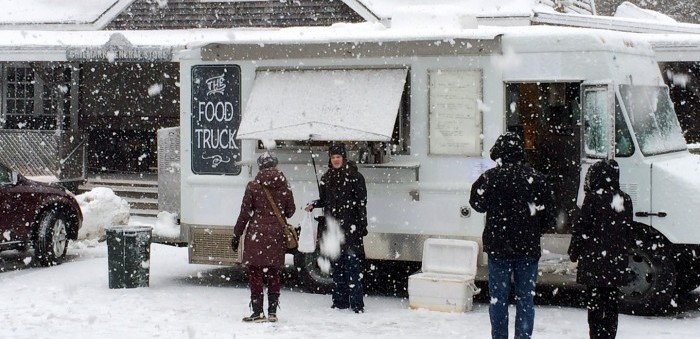Although it isn’t quite Winter yet, recently we have noticed a few Twitter messages from food trucks around the country were preparing to shut down until Spring. Unless your mobile food business is located in the warmer climate areas in the United States, the first frost is usually a sign that it’s time to start thinking about putting your food truck away for the winter. Proper food truck Winter storage can save you a lot of work down the road.
In this article we will share a few food truck winter storage tips you should follow before packing your vehicle away for the winter. Come next spring, your vehicle will look great and perform well.
Food Truck Winter Storage Tips
Before you begin, be sure when taking parts apart, to be organized. Keep similar parts together in a safe place where they won’t get lost and layout parts in a way that will allow you to put them back in the same order.
Make Safety Your Top Priority
Every vehicle is different. When it comes to maintenance and repairs always follow the vehicle’s owner’s manual. Make sure you have all of your tools and supplies before you begin – the last thing you want to do is go shopping when you have the car on the jack.
Safety should be your number one priority. Don’t smoke, drink alcoholic beverages, or wear exposed jewelry while working on your food truck. Watch out for hot objects, sharp instruments, hazardous materials and other potential safety hazards in and around your workspace. Always wear a set of safety glasses, a dust mask and latex gloves.
Do not work with a Philips when the job calls for a flat screwdriver. Substituting tools can compromise your safety.
Finally, when the fun turns to frustration or if the job requires specialized knowledge beyond your abilities, seek the assistance of a professional mechanic. The last thing we want is someone getting hurt.
Perform All Repairs And Maintenance
Perform any known repairs or maintenance on your vehicle. You don’t want to forget and find out the hard way on the first spring drive.
RELATED: Winter Food Truck Maintenance Checklist
Change The Oil
Change your engine oil and filter. You don’t want contaminants that have built up in the oil to sit in your engine all winter. Change the oil again when taking the truck out in spring to remove any condensation build up in the oil pan.
Fill The Tank
Add a container of fuel stabilizer to the fuel tank and completely fill the tank with high quality gasoline. Drive a quick 10 miles or so to work the stabilizer through the entire fuel system.
Prevent Rust
Spray hinges, crevices, and anything shiny with a coating of WD-40 to prevent rusting. This can be wiped off in the spring with a degreaser. If you are using a rust inhibiting coating on the exterior, it should be applied now. Let the vehicle sit for a few days before washing and waxing.
Wash And Wax
You’ll want to do a complete and thorough cleaning before storage. Wash the car, inside and out. Wax all painted surfaces with a high quality wax.
Remove Kitchen Equipment
If your mobile bistro isn’t going to be stored in a heated area this step should be followed. If any of your kitchen equipment is not bolted down, remove it from your food truck and store it in a secure heated area.
Clean all of the remaining kitchen equipment to make sure there is no food to sit and spoil over the winter. Prop open your oven and refrigeration units to prevent mold from building up and ruining this equipment.
Wipe Down Rubber Parts
Wipe all rubber parts and seals with a rubber dressing to stop them from drying out and cracking.
Battery Maintenance
At the very least, disconnect the battery cables. If your storage area is not heated, it’s recommended that the battery is removed and stored indoors through the winter, but always watch for the possibility of corrosive battery acid.
IMPORTANT – Before disconnecting a battery, be sure you disarm any alarms and that you have any necessary lock codes for the stereo or other electronic equipment.
It’s important to maintain the battery to prolong its ability to hold a charge as time goes by. Battery maintenance can be done in a few different ways:
- Trickle charge the battery every few weeks with a battery charger.
- Use a battery charger that has a “maintain” setting so the battery is kept at the right state of charge, but not overcharged.
- Use a 12V solar panel and battery maintainer to constantly monitor/charge the battery.
Fill Washer Fluid
Fill your washer fluid container with winter washer fluid to prevent freezing and cracking of the fluid container.
Keep The Critters Out
Cover or plug the exhaust tail pipe and air intake tubing to prevent rodents from taking up residence. Steel wool works well, just remember to remove it before starting the car! Some people also like to use mothballs under the hood or in the trunk to keep rodents away. It’s NOT recommended to use mothballs on the interior of your food truck.
On The Ground? Off The Ground?
Next you’ll need to decide whether to raise the vehicle for food truck winter storage or leave it sitting on the ground. Flat spots on the tires used to be the main reason to store a vehicle raised off the ground, but with modern day tires, this has become less of an issue. Generally, if the truck is only parked for the winter, storing it on the ground should be fine. Over-inflating your tires by 5-8 pounds can help prevent flat spotting over the winter.
If you are raising it off the ground, you’re next decision is whether or not to remove the wheels. Some people prefer to remove the wheels when storing a car, rather than have them in a high traffic garage area where your rims can be damaged.
IMPORTANT – DO NOT use the parking brake when storing a vehicle. Parking brakes can seize over months of being left on.
Cover It Up
First, leave the windows down a few inches to let the interior breathe then cover the truck. Covers should be a breathable, snug fitting material. Tarps or plastic are not recommended.
Make Sure You Are ‘Covered’
Adjust your insurance accordingly. Call your insurance agent and let them know your food truck has been stored. They can recommend the appropriate amount of insurance.
RELATED: Food Truck Storage Insurance Tips
The Bottom Line
Prepping your food truck for Winter storage will save you a ton of headaches come Spring. Follow these simple steps to get your vehicle ready for the long cold months it will be sitting around waiting for you to fire it back up.
Do you have any additional tips for Food Truck Winter Storage? Share your thoughts on this topic in the comment section, our food truck forum or social media. Twitter | Facebook




